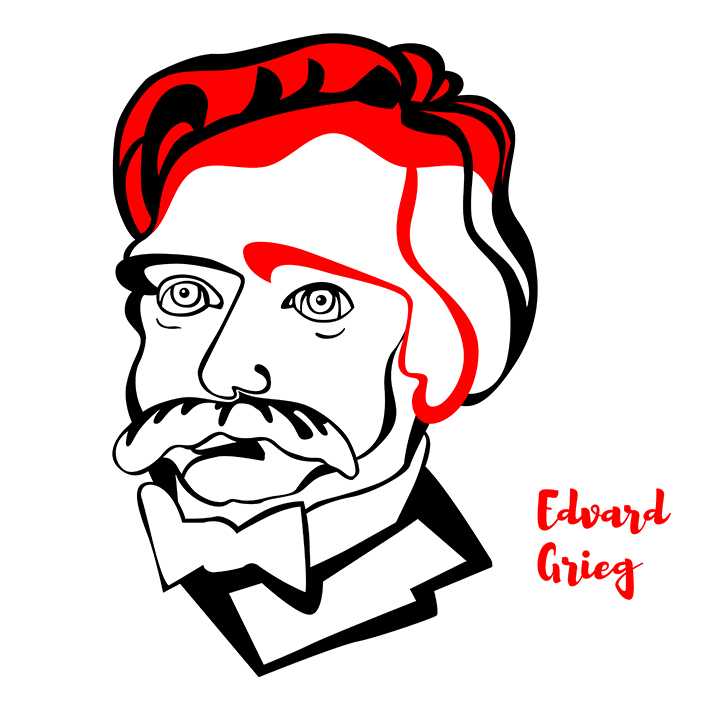It is safe to say, not many classical composers are well-known to the general public, however there are some exceptions, and among these is the Norwegian composer, Edvard Grieg. His famous works have become world-wide favorites and the “Peer Gynt Suites” are at the top of the list.
The Composer
Edvard Grieg (1843-1907) was born in Bergen, Norway. His early training, at age six, was from his mother who started him on music lessons. At age 15, he went to Leipzig, Germany and studied piano and composition at the Leipzig Conservatory. It was reported that he conflicted with the school’s philosophy, so he eventually returned to Norway. After returning to Norway, Grieg met with Rikard Nordraak and together they organized the Norwegian Nationalist School of Music. In 1867, Grieg founded the Music Union in Christiana, (now Oslo) and was its conductor until 1880.

Scandinavian nationalism in general, can be described as a reaction to German-romanticism. This was due to some Scandinavian composers receiving their early training in Leipzig. Grieg was considered the most popular of the Scandinavian nationalist composers. He loved the customs, native traditions and wild mountain scenery of his native country. Grieg was creating a “Nordic Sound.” He was an important factor in furthering Norwegian nationalism by writing pieces using traditional aspects based on popular music. He took an active role in the national musical life of Norway.
Nationalism had a local flavor with its roots in Russia. Scandinavian composers reached for an indigenous style. Nationalism in music stressed native folk songs and subjects of national interests. Other countries were also experimenting with native folk music.
Music
Grieg’s concept of Norwegian music was to use the charm and attractiveness of native folk music. He was able to write beautiful music incorporating original subtle harmonies, folk-like melodies and distinctive dance rhythms. He firmly believed that Norwegian music expressed the spirit of the north.
Grieg’s music drew public attention through his many piano pieces, songs, sonatas for violin and piano, and other incidental music connected with his suites.
His famous Piano Concerto in A minor was one of his signature pieces that gave him prominence and much admiration.
Peer Gynt Suite was one of Grieg’s most celebrated and famous compositions. It was commissioned by Henrik Ibsen, author and playwright. He wanted Grieg to write incidental music for his play, Peer Gynt—a story of fairies of a different variety. This gave Grieg a vehicle to tell in musical terms the story of this Norwegian tale.
Originally, in earlier times, a suite was comprised of dance tunes all in the same key. Four tunes were common, although in some suites many more were used. The four usual dances were: Allemande, Courante, Saraband, and the Gigue. These classic dance forms are no longer used.
The sections in the suite that describe the core of the story are: “In The Hall of the Mountain King,” “Death of Ase,” “Arabian Dance,” “Anitras Dance,” and “Morning.”
“The Lulllaby,”in the suite is a combination cradle song in dirge. The Peer Gynt Suite made Grieg an overnight sensation as the suite was a tremendously popular success.
In 1884, Grieg accepted a commission to write a suite honoring Ludvig Holberg, the Norwegian philosopher and playwright. It started out as a five-movement piano piece and later he arranged it for string orchestra. This became the favorite version of the Holberg suite. It was very popular and met with great success.
Grieg’s reputation was very well established by 1885, with a body of substantial and popular works endorsed and enjoyed by the public. His writing took on a schedule of composing in the spring and early summer, and in the fall and winter he went on concert tours as he was always in demand. An ironic chapter in his life was, he was excellent as a miniaturist – he excelled in composing smaller forms and was thought by some to be without equal. He enjoyed listening to the longer forms, like symphonies and operas, but he felt he could not write the longer forms as well as other composers. He was dubbed the “Chopin of the North,” as he and Chopin both wrote in shorter forms.
Around 1862 Grieg went to Copenhagen where he met his cousin and future wife, Nina Hayerup. He built them a house in Troldhaugen where they lived the rest of their lives. Grieg has emerged in modern times as one of the most popular, serious composers of all times.
Long live his musical treasures.
Leave a Reply